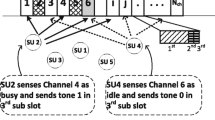Abstract
In a cognitive radio network with energy-harvesting secondary nodes, the energy states of nodes may be different depending on the time-varying amount of harvesting and consuming energy. The contention strategy needs to take the effect into consideration to save energy and increase the lifetime of secondary nodes. In this paper, an efficient sensing mechanism and a contention algorithm for a cognitive radio network with energy-harvesting nodes is presented. In order to prevent imminent outage of low energy nodes, higher priorities are given to low energy nodes during contention, which gives more transmission opportunities to low energy nodes before they go into the sleep mode. We propose to use differentiated access probabilities and contention windows for different energy levels. By utilizing the access probabilities of secondary nodes, the number of the contending nodes and the energy consumption decrease. The differentiated contention windows ensure the transmission priority of low energy nodes. The proposed MAC protocol is shown to enhance throughput and energy efficiency. The throughput and energy efficiency of the proposed MAC are investigated via analysis by a Markov chain and simulations.













Similar content being viewed by others
References
Molisch, A. F. (2010). Applications and requirements of wireless services, In Wireless communications (2nd ed., pp. 3–4). Wiley.
Kennedy, M., Ksentini, A., Hadjadj-Aoul, Y., & Muntean, G.-M. (2013). Adaptive energy optimization in multimedia-centric wireless devices: A survey. IEEE communications surveys & tutorials (Vol. 15, no. 2, pp. 768–786). Second Quarter 2013.
Rao, R., Vrudhula, S., & Rakhmatov, D. N. (2003). Battery modeling for energy aware system design. Transactions on Computer, 36(12), 77–87.
Li, M., Lou, W., & Ren, K. (2010). Data security and privacy in wireless body area networks. IEEE Wireless Communications, 17(1), 51–58.
Rubinstein, M. G., Moraes, I. M., Campista, M. E. M., Costa, L. H. M. K., Carlos, O., & Duarte, M. B. (2006). A survey on wireless ad hoc networks. In Proceedings of IEEE conference on mobile and wireless communications networks (pp. 1–33).
Yoon, H.-W., Lee, B.-H., Lee, T.-J., & Chung, M. Y. (2004). Energy efficient routing with power management to increase network lifetime in sensor networks. Springer-Verlag Lecture Notes in Computer Science, 3046, 58–67.
Kim, J., & Lee, J.-W. (2011). Energy adaptive MAC protocol for wireless sensor networks with RF energy transfer. In Proceedings of international conference on ubiquitous and future networks (ICUFN) (pp. 89–94).
Huang, P., Xiao, L., Soltani, S., Mutka, M. W., & Xi, N. (2011). The evolution of MAC protocols in wireless sensor networks: A survey. In IEEE communications surveys & tutorials (Vol. 15, no. 1, pp. 101–120). First Quarter 2011.
Gündüz, D., Stamatiou, K., Michelusi, N., & Zorzi, M. (2014). Designing intelligent energy harvesting communication systems. IEEE Communications Magazine, 52(1), 210–216.
Sudevalayam, S., & Kulkarni, P. (2011). Energy harvesting sensor nodes: Survey and implications. IEEE Communications Survey Tutorials, 13(3), 443–461.
Chen, H. (2010). Performance-energy tradeoffs for decentralized estimation in a multihop sensor network. IEEE Sensors Journal, 10(8), 1304–1310.
Kim, Y., Park, C. W., & Lee, T.-J. (2014). MAC protocol for energy-harvesting users in cognitive radio networks. In Proceedings of ACM international conference on ubiquitous information management and communication (ICUIMC).
MacKenzie, A. B., Reed, J. H., Athanas, P., Bostian, C. W., Buehrer, R. M., DaSilva, L. A., et al. (2009). Cognitive radio and networking research at virginia Tech. In Proceedings of the IEEE (Vol. 97, no. 4, pp. 660–688).
Wang, B., & Liu, K. J. R. (2011). Advances in cognitive radio networks: A survey. IEEE Journal of Selected Topics in Signal Processing, 5(1), 5–23.
Wang, J., Ghosh, M., & Challapali, K. (2011). Emerging cognitive radio applications: A survey. IEEE Communications Magazine, 49(3), 74–81.
Lee, M., Cho, T.-K., & Lee, T.-J. (2013). Cooperative multichannel MAC protocol using discontiguous-OFDM in cognitive radio ad hoc networks. IEICE transactions on communications (Vol. E96-B, no. 8, pp. 2139–2149).
Driouch, E., & Ajib, W. (2013). Downlink scheduling and resource allocation for cognitive radio MIMO networks. IEEE transactions on vehicular technology (Vol. 62, no. 8).
De Domenico, A., Strinati, E. C., & Di Benedetto, M. (2012). A survey on MAC strategies for cognitive radio networks. IEEE Communications Surveys Tutorials, 14(1), 21–44.
Chen, Q., Wong, W.-C., Motani, M., & Liang, Y.-C. (2013). MAC protocol design and performance analysis for random access cognitive radio networks. IEEE J. Sel. Areas Commun., 31(11), 2289–2300.
Lim, S., & Lee, T.-J. (2011). A self-scheduling multi-channel cognitive radio MAC protocol based on cooperative communications. IEICE Transactions on Communications, E94–B(6), 1657–1668.
Park, S., Kim, H., & Hong, D. (2013). Cognitive radio networks with energy harvesting. IEEE Trans. Wireless Commun., 12(3), 1386–1397.
Yin, S., Zhang, E., Qu, Z., Yin, L., & Li, S. (2014). Optimal cooperation strategy in cognitive radio systems with energy harvesting. IEEE transactions on wireless communications (Vol. 13, no. 9).
Bianchi, G. (2000). Performance analysis of the IEEE 802.11 distributed coordination function. IEEE Journal on Selected Areas in Communications, 18(3), 535–547.
Sakurai, T., & Vu, H. L. (2007). MAC access delay of IEEE 802.11 DCF. IEEE Transactions on Wireless Communications, 6(5), 1702–1710.
Author information
Authors and Affiliations
Corresponding author
Additional information
An early version of this work was presented at ICUIMC 2014. This work was supported by the National Research Foundation of Korea (NRF) grant funded by the Korean government (MSIP) (2014R1A5A1011478).
Rights and permissions
About this article
Cite this article
Kim, Y., Park, C.W. & Lee, TJ. Differentiated Access Mechanism in Cognitive Radio Networks with Energy-Harvesting Nodes. Wireless Pers Commun 90, 2051–2071 (2016). https://doi.org/10.1007/s11277-016-3437-z
Published:
Issue Date:
DOI: https://doi.org/10.1007/s11277-016-3437-z




